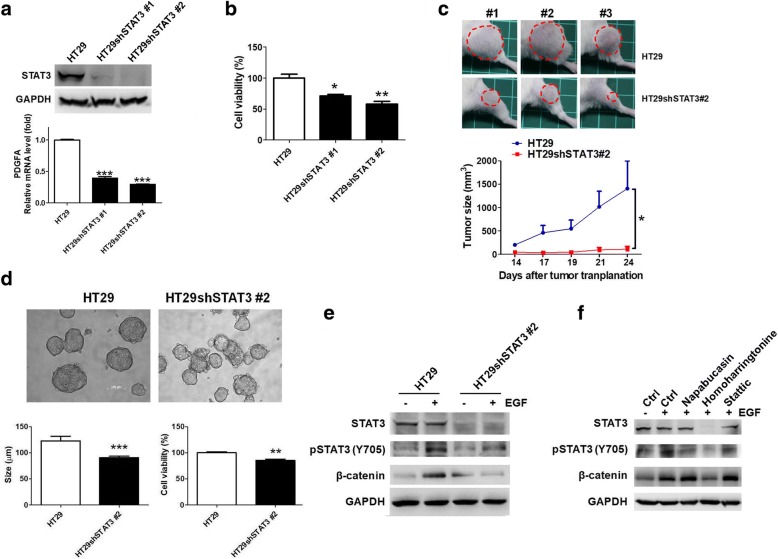Fig. 5.
STAT3 knockdown reduced cell viability of HT29 cells and formation and survival of HT29-derived tumorspheres through inhibition of EGF-induced STAT3 phosphorylation. (a) STAT3 was knocked down using shRNA technique and measured using Western blot analysis, leading to the downregulation of PGDFA and (b) reduction of cell viability in HT29 cells. (c) We demonstrated that knockdown of STAT3 in HT29 cells (HT29shSTAT3#2) significantly reduced the tumor growth compared to parental HT29 cells in tumor xenografts (n = 3). Tumors are indicated by red circles. (d) To validate the involvement of STAT3 in the formation of cancer stem-like cells, the HT29 and HT29shSTAT3 cells cultured in serum-free medium with addition of EGF, bFGF, insulin, and heparin for 7 days were observed and investigated. The diameters of tumorspheres in the HT29shSTAT3 cells decreased compared with HT29 cells. In addition, the cell viability was reduced in the HT29shSTAT3 cells. (e) To verify whether STAT3 determines the activation of the Wnt signaling pathway, STAT3 phosphorylation and β-catenin expression were observed after treatment with 20 ng/mL of EGF for 2 h. The results demonstrated that EGF led to STAT3 phosphorylation and β-catenin overexpression in HT29 cells; however, there was no significant difference in HT29shSTAT3 cells, indicating that STAT3 determines the EGF-exacerbated Wnt signaling activation for the formation and survival of EGFR-positive cancer stem-like tumorspheres. (f) Consequently, to clarify the mechanism of homoharringtonine against the formation and survival of tumorspheres, STAT3 inhibitors were added to HT29 cells in 1 μM and incubated for 48 h. Homoharringtonine remarkably inhibited STAT3 expression and reduced EGF-mediated β-catenin expression. *p < 0.05. **p < 0.01. ***p < 0.001

